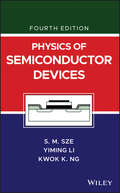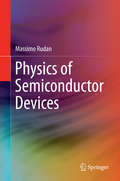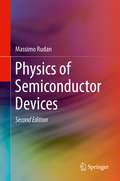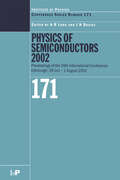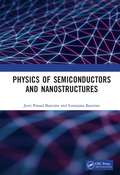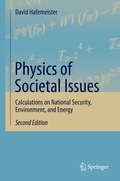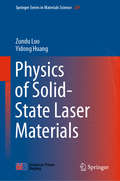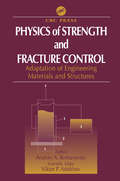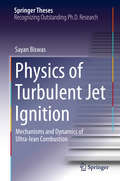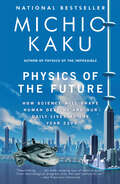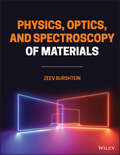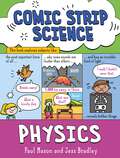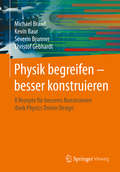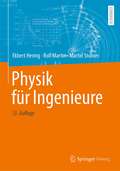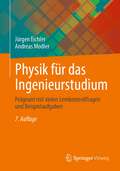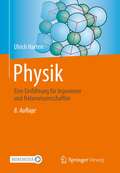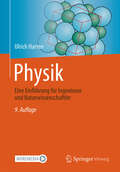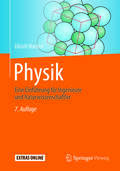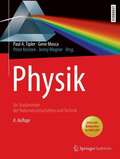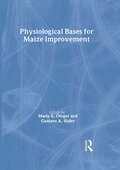- Table View
- List View
Physics of Radiation and Climate
by Michael A. Box Gail P. BoxOur current climate is strongly influenced by atmospheric composition, and changes in this composition are leading to climate change. Physics of Radiation and Climate takes a look at how the outward flow of longwave or terrestrial radiation is affected by the complexities of the atmosphere's molecular spectroscopy. This book examines the planet in
Physics of Radio-Frequency Plasmas
by Pascal Chabert Nicholas BraithwaiteLow-temperature radio frequency plasmas are essential in various sectors of advanced technology, from micro-engineering to spacecraft propulsion systems and efficient sources of light. The subject lies at the complex interfaces between physics, chemistry and engineering. Focusing mostly on physics, this book will interest graduate students and researchers in applied physics and electrical engineering. The book incorporates a cutting-edge perspective on RF plasmas. It also covers basic plasma physics including transport in bounded plasmas and electrical diagnostics. Its pedagogic style engages readers, helping them to develop physical arguments and mathematical analyses. Worked examples apply the theories covered to realistic scenarios, and over 100 in-text questions let readers put their newly acquired knowledge to use and gain confidence in applying physics to real laboratory situations.
Physics of Semiconductor Devices
by Simon M. Sze Kwok K. Ng Yiming LiThe new edition of the most detailed and comprehensive single-volume reference on major semiconductor devices The Fourth Edition of Physics of Semiconductor Devices remains the standard reference work on the fundamental physics and operational characteristics of all major bipolar, unipolar, special microwave, and optoelectronic devices. This fully updated and expanded edition includes approximately 1,000 references to original research papers and review articles, more than 650 high-quality technical illustrations, and over two dozen tables of material parameters. Divided into five parts, the text first provides a summary of semiconductor properties, covering energy band, carrier concentration, and transport properties. The second part surveys the basic building blocks of semiconductor devices, including p-n junctions, metal-semiconductor contacts, and metal-insulator-semiconductor (MIS) capacitors. Part III examines bipolar transistors, MOSFETs (MOS field-effect transistors), and other field-effect transistors such as JFETs (junction field-effect-transistors) and MESFETs (metal-semiconductor field-effect transistors). Part IV focuses on negative-resistance and power devices. The book concludes with coverage of photonic devices and sensors, including light-emitting diodes (LEDs), solar cells, and various photodetectors and semiconductor sensors. This classic volume, the standard textbook and reference in the field of semiconductor devices: Provides the practical foundation necessary for understanding the devices currently in use and evaluating the performance and limitations of future devices Offers completely updated and revised information that reflects advances in device concepts, performance, and application Features discussions of topics of contemporary interest, such as applications of photonic devices that convert optical energy to electric energy Includes numerous problem sets, real-world examples, tables, figures, and illustrations; several useful appendices; and a detailed solutions manual Explores new work on leading-edge technologies such as MODFETs, resonant-tunneling diodes, quantum-cascade lasers, single-electron transistors, real-space-transfer devices, and MOS-controlled thyristors Physics of Semiconductor Devices, Fourth Edition is an indispensable resource for design engineers, research scientists, industrial and electronics engineering managers, and graduate students in the field.
Physics of Semiconductor Devices
by Massimo RudanThis book describes the basic physics of semiconductors, including the hierarchy of transport models, and connects the theory with the functioning of actual semiconductor devices. Details are worked out carefully and derived from the basic physics, while keeping the internal coherence of the concepts and explaining various levels of approximation. Examples are based on silicon due to its industrial importance. Several chapters are included that provide the reader with the quantum-mechanical concepts necessary for understanding the transport properties of crystals. The behavior of crystals incorporating a position-dependent impurity distribution is described, and the different hierarchical transport models for semiconductor devices are derived (from the Boltzmann transport equation to the hydrodynamic and drift-diffusion models). The transport models are then applied to a detailed description of the main semiconductor-device architectures (bipolar, MOS). The final chapters are devoted to the description of some basic fabrication steps, and to measuring methods for the semiconductor-device parameters.
Physics of Semiconductor Devices
by Massimo RudanThis book describes the basic physics of semiconductors, including the hierarchy of transport models, and connects the theory with the functioning of actual semiconductor devices. Details are worked out carefully and derived from the basic physics, while keeping the internal coherence of the concepts and explaining various levels of approximation. Examples are based on silicon due to its industrial importance. Several chapters are included that provide the reader with the quantum-mechanical concepts necessary for understanding the transport properties of crystals. The behavior of crystals incorporating a position-dependent impurity distribution is described, and the different hierarchical transport models for semiconductor devices are derived (from the Boltzmann transport equation to the hydrodynamic and drift-diffusion models). The transport models are then applied to a detailed description of the main semiconductor-device architectures (bipolar, MOS). The final chapters are devoted to the description of some basic fabrication steps, and to measuring methods for the semiconductor-device parameters.
Physics of Semiconductors 2002: Proceedings of the 26th International Conference, Edinburgh, 29 July to 2 August 2002 (Institute of Physics Conference Series)
by A R Long J H DaviesThe 26th International Conference on the Physics of Semiconductors was held from 29 July to 2 August 2002 at the Edinburgh International Conference Centre. It is the premier meeting in the field of semiconductor physics and attracted over 1000 participants from leading academic, governmental and industrial institutions in some 50 countries around the world. Plenary and invited papers (34) have been printed in the paper volume, and all submitted papers (742) are included on the downloadable resources.These proceedings provide an international perspective on the latest research and a review of recent developments in semiconductor physics. Topics range from growth and properties of bulk semiconductors to the optical and transport properties of semiconductor nanostructures. There are 742 papers, mostly arranged in chapters on Bulk, dynamics, defects and impurities, growth (147); Heterostructures, quantum wells, superlattices - optical (138); Heterostructures, quantum wells, superlattices - transport (97); Quantum nanostructures - optical (120); Quantum nanostructures - transport (85); New materials and concepts (52); Novel devices (43); and Spin and magnetic effects (48). A number of trends were identified in setting up the overall programme of the conference. There were significant contributions from new directions of research such as nanostructures and one-dimensional physics; spin effects and ferromagnetism; and terahertz and subband physics. These complemented areas in which the conference has traditional strengths, such as defects and bulk materials; crystal growth; quantum transport; and optical properties.As a record of a conference that covers the whole range of semiconductor physics, this book is an essential reference for researchers working on semiconductor physics, device physics, materials science, chemistry, and electronic and electrical engineering.
Physics of Semiconductors and Nanostructures
by Jyoti Prasad Banerjee Suranjana BanerjeeThis book is a comprehensive text on the physics of semiconductors and nanostructures for a large spectrum of students at the final undergraduate level studying physics, material science and electronics engineering. It offers introductory and advanced courses on solid state and semiconductor physics on one hand and the physics of low dimensional semiconductor structures on the other in a single text book. Key Features Presents basic concepts of quantum theory, solid state physics, semiconductors, and quantum nanostructures such as quantum well, quantum wire, quantum dot and superlattice In depth description of semiconductor heterojunctions, lattice strain and modulation doping technique Covers transport in nanostructures under an electric and magnetic field with the topics: quantized conductance, Coulomb blockade, and integer and fractional quantum Hall effect Presents the optical processes in nanostructures under a magnetic field Includes illustrative problems with hints for solutions in each chapter Physics of Semiconductors and Nanostructures will be helpful to students initiating PhD work in the field of semiconductor nanostructures and devices. It follows a unique tutorial approach meeting the requirements of students who find learning the concepts difficult and want to study from a physical perspective.
Physics of Societal Issues
by David HafemeisterThis book provides the reader with essential tools needed to analyze complex societal issues and demonstrates the transition from physics to modern-day laws and treaties. This second edition features new equation-oriented material and extensive data sets drawing upon current information from experts in their fields. Problems to challenge the reader and extend discussion are presented on three timely issues: * National Security: Weapons, Offense, Defense, Verification, Nuclear Proliferation, Terrorism * Environment: Air/Water, Nuclear, Climate Change, EM Fields/Epidemiology * Energy: Current Energy Situation, Buildings, Solar Buildings, Renewable Energy, Enhanced End-Use Efficiency, Transportation, Economics Praise for the first edition: "This insight is needed in Congress and the Executive Branch. Hafemeister, a former Congressional fellow with wide Washington experience, has written a book for physicists, chemists and engineers who want to learn science and policy on weapons, energy, and the environment. Scientists who want to make a difference will want this book. " Richard Scribner, first Director, Congressional Science and Engineering Fellow Program, AAAS "Hafemeister shows how much one can understand about nuclear weapons and missile issues through simple back-of-the-envelope calculations. He also provides compact explanations of the partially successful attempts that have been made over the past 60 years to control these weapons of mass destruction. Hopefully, Physics of Societal Issues will help interest a new generation of physicists in continuing this work. " Frank von Hippel, Professor, Princeton, former Assistant Director, National Security, White House, OSTP "Energy policy must be quantitative. People who don't calculate economic tradeoffs often champion simplistic hardware. 'The solution is more. . . nuclear power, or electric cars, or photovoltaics, etc. ' Some simple physics will show that the true solution matches supply and demand as an 'integrated resource plan. ' Physics of Societal Issues is a good place to begin this journey. " Arthur Rosenfeld, former California Energy Commissioner, Professor-emeritus, U. of California-Berkeley
Physics of Solar Energy and Energy Storage
by C. Julian ChenPHYSICS OF SOLAR ENERGY AND ENERGY STORAGE Join the fight for a renewable world with this indispensable introduction Solar energy is one of the most essential tools in the fight to create a sustainable future. A wholly renewable and cost-effective energy source capable of providing domestic, business, and industrial energy, solar energy is expected to become a $223 billion a year industry by 2026. The future of global energy production demands researchers and engineers who understand the physics of harnessing, storing, and distributing solar energy. Physics of Solar Energy and Energy Storage begins to meet this demand, with a thorough, accessible overview of the required fundamentals. Now fully updated to reflect the past decade of research amidst a growing understanding of the scale of our collective challenge, it promises to train the next generation of researchers and engineers who will join this vital effort. Readers of the second edition of Physics of Solar Energy and Energy Storage will find: A particular focus on lithium-ion rechargeable batteries Detailed discussions of photovoltaic solar systems, concentrating solar systems, passive solar heating, and more Homework problems and exercises throughout to reinforce learning Physics of Solar Energy and Energy Storage is ideal for mechanical, chemical, or electrical engineers working on solar or alternative energy projects, as well as researchers and policymakers in related fields.
Physics of Solid-State Laser Materials (Springer Series in Materials Science #289)
by Zundu Luo Yidong HuangThis book discusses the spectral properties of solid-state laser materials, including emission and absorption of light, the law of radiative and nonradiative transitions, the selection rule for optical transitions, and different calculation methods of the spectral parameters. The book includes a systematic presentation of the authors' own research works in this field, specifically addressing the stimulated nonradiative transition theory and the apparent crystal field model. This volume is helpful resource for researchers and graduate students in the fields of solid spectroscopy and solid-state laser material physics, while also serving as a valuable reference guide for instructors and advanced students of physics.
Physics of Strength and Fracture Control: Adaptation of Engineering Materials and Structures
by Viktor P. Astakhov Anatoly A. KomarovskyStill passive and for the most part uncontrollable, current systems intended to ensure the reliability and durability of engineering structures are still in their developmental infancy. They cannot make corrections or recondition materials, and most material and structural failures cannot be predicted. Accidents-and catastrophes-result.Phys
Physics of Turbulent Jet Ignition: Mechanisms And Dynamics Of Ultra-lean Combustion (Springer Theses)
by Sayan BiswasThis book focuses on developing strategies for ultra-lean combustion of natural gas and hydrogen, and contributes to the research on extending the lean flammability limit of hydrogen and air using a hot supersonic jet. The author addresses experimental methods, data analysis techniques, and results throughout each chapter and:Explains the fundamental mechanisms behind turbulent hot jet ignition using non-dimensional analysisExplores ignition characteristics by impinging hot jet and multiple jets in relation to better controllability and lean combustionExplores how different instability modes interact with the acoustic modes of the combustion chamber.This book provides a potential answer to some of the issues that arise from lean engine operation, such as poor ignition, engine misfire, cycle-to-cycle variability, combustion instability, reduction in efficiency, and an increase in unburned hydrocarbon emissions. This thesis was submitted to and approved by Purdue University.
Physics of Wurtzite Nitrides and Oxides
by Bernard GilThis book gives a survey of the current state of the art of a special class of nitrides semiconductors, Wurtzite Nitride and Oxide Semiconductors. It includes properties, growth and applications. Research in the area of nitrides semiconductors is still booming although some basic materials sciences issues were solved already about 20 years ago. With the advent of modern technologies and the successful growth of nitride substrates, these materials currently experience a second birth. Advanced new applications like light-emitters, including UV operating LEDs, normally on and normally off high frequency operating transistors are expected. With progress in clean room technology, advanced photonic and quantum optic applications are envisioned in a close future. This area of research is fascinating for researchers and students in materials science, electrical engineering, chemistry, electronics, physics and biophysics. This book aims to be the ad-hoc instrument to this active field of research.
Physics of the Future: How Science Will Shape Human Destiny and Our Daily Lives by the Year 2100
by Michio KakuNATIONAL BESTSELLER • The renowned theoretical physicist and national bestselling author of The God Equation details the developments in computer technology, artificial intelligence, medicine, space travel, and more, that are poised to happen over the next century. &“Mind-bending…. [An] alternately fascinating and frightening book.&” —San Francisco ChronicleSpace elevators. Internet-enabled contact lenses. Cars that fly by floating on magnetic fields. This is the stuff of science fiction—it&’s also daily life in the year 2100.Renowned theoretical physicist Michio Kaku considers how these inventions will affect the world economy, addressing the key questions: Who will have jobs? Which nations will prosper? Kaku interviews three hundred of the world&’s top scientists—working in their labs on astonishing prototypes. He also takes into account the rigorous scientific principles that regulate how quickly, how safely, and how far technologies can advance. In Physics of the Future, Kaku forecasts a century of earthshaking advances in technology that could make even the last centuries&’ leaps and bounds seem insignificant.
Physics of the Terrestrial Environment, Subtle Matter and Height of the Atmosphere: Conceptions of the Atmosphere and the Nature of Air in the Age of Enlightenment
by Eric ChassefiereThe discovery, in the middle of the 17th century, of both the weight of air and the law governing its elasticity transformed the status of the atmosphere from that of a purely mathematical object to that of a complex and highly variable physical system.In the context of rapidly intensifying experimentation and observation, the nature of the atmosphere was therefore the subject of a host of hypotheses, which 18th century scholars tried to reconcile with a coherent physical approach. In particular, this was achieved by the conceptualization of invisible or “subtle” materials, thought to be closely linked to atmospheric stratification.Subtle matter was introduced, largely to reconcile contradictory results concerning the estimation of the height of the atmosphere. These estimations were based on different methods, mainly using the observation of meteors and the refracted and reflected light of stars.Taking as its common thread the question of the height of the atmosphere, which was omnipresent in the texts at the time, this book traces the history of the discovery of the atmosphere and the many questions it generated.
Physics, Optics, and Spectroscopy of Materials
by Zeev BurshteinPHYSICS, OPTICS, AND SPECTROSCOPY OF MATERIALS Bridges a gap that exists between optical spectroscopists and laser systems developers Physics, Optics, and Spectroscopy of Materials provides professionals and students in materials science and engineering, optics, and spectroscopy a basic understanding and tools for stimulating current research, as well as developing and implementing new laser devices in optical spectroscopy. The author—a noted expert on that subject matter—covers a wide range of topics including: effects of light and mater interaction such as light absorption, emission and scattering by atoms and molecules; energy levels in hydrogen, hydrogen-like atoms, and many electron atoms; electronic structure of molecules, classification of vibrational and rotational motions of molecules, wave propagation and oscillations in dielectric solids, light propagation in isotropic and anisotropic solids, including frequency doubling dividing and shifting, solid materials optics, and lasers. The book provides a basic overview of the laser and its comprising components. For example, the text describes methods for achieving fast Q-switching in laser cavities, and illustrates examples of several specific laser systems used in industry and scientific research. This important book: Provides a comprehensive background in material physics, optics, and spectroscopy Details examples of specific laser systems used in industry and scientific research including helium/neon laser, copper vapor laser, hydrogen-fluoride chemical laser, dye lasers, and diode lasers Presents a basic overview of the laser and its comprising components Elaborates on several important subjects in laser beams optics: divergence modes, lens transitions, and crossing of anisotropic crystals Written for research scientists and students in the fields of laser science and technology and materials optical spectroscopy, Physics, Optics, and Spectroscopy of Materials covers knowledge gaps for concepts including oscillator strength, allowed and forbidden transitions between electronic and vibrational states, Raman scattering, and group-theoretical states nomenclature.
Physics: The science of forces, energy and simple machines (Comic Strip Science #3)
by Paul MasonComic Strip Physics makes learning about the science behind forces, energy and simple machines fun! Each spread in this series features a short, funny comic strip that explains a process or aspect of science. Around the strip, diagrams and panels give further information on the topic. They are a fantastic way to engage children aged 8 plus with science.The illustrator, Jess Bradey, is winner of the 2021 Blue Peter Award for Best Non-Fiction for A Day in the Life of a Poo, Gnu and You and also writes and draws for The Phoneix Comic. Titles in the series: Biology, Chemistry, Earth and Space, Physics.
Physik begreifen – besser konstruieren: 8 Rezepte für besseres Konstruieren dank Physics Driven Design
by Michael Brand Christof Gebhardt Kevin Baur Severin BrunnerNeue Produkte zu entwerfen und funktional zu gestalten, ist eine höchst kreative und verantwortungsvolle Aufgabe. Wenn Sie die Physik hinter Ihrem Design beherrschen gelingt es Ihnen ganz selbstverständlich, besser, nämlich entlang der gewünschten Funktion, zu konstruieren.Die vorliegenden 8 Rezepte sind nicht einfach Konstruktionsvorschriften, sondern aus jahrelanger Erfahrung abgeleitete Empfehlungen, die alle einen erklärbaren physikalischen Hintergrund haben. Warum funktioniert es besser, eine Konstruktion zugdominant statt biegedominant zu gestalten? Wie verteilt man die Steifigkeiten am besten, um einen optimalen Kraftfluss zu erhalten? Was passiert an Stellen, an denen man eine Strömung umlenkt und wie kann man das mit geringsten Verlusten steuern?Die Autoren führen Sie durch die 8 Rezepte und erklären Ihnen, worauf Sie achten müssen und warum es funktioniert. Anhand konkreter Beispiele aus dem Konstruktionsalltag werden die Rezepte ausprobiert und viele Varianten durchgetestet. Bei diesem spielerischen Ausprobieren von verschiedenen Szenarien schauen Sie den Autoren über die Schulter und können erleben, wie das Verständnis um die physikalische Wirkung die Evolution des Designs steuert. Alle Beispiele wurden mit ANSYS Discovery Live aufbereitet und stehen zum Download bereit, sodass Sie selbst die Rezepte ausprobieren und auf Ihre Anwendungen übertragen können.
Physik für Ingenieure
by Ekbert Hering Rolf Martin Martin StohrerDieses Lehrbuch zeichnet sich durch klare Strukturen, bewährte Didaktik und Übersichten zur Veranschaulichung komplexer Zusammenhänge aus. Zahlreiche Abbildungen aus der Technik und Berechnungsbeispiele aus dem Arbeitsumfeld des Ingenieurs vermitteln den Praxisbezug. Übungsaufgaben und deren ausführliche Lösungen ermöglichen es, physikalische Zusammenhänge rechnerisch zu erfassen und vertiefen ihr Verständnis. Dieses erfolgreiche Standardwerk erscheint in seiner 12. Auflage. Auf den Innenseiten des Einbands finden sich nun in übersichtlicher Zusammenstellung wichtige physikalische Naturkonstanten, eine Tabelle zur Umrechnung von Energieäquivalenten sowie eine Liste öfters anzutreffender, jedoch nicht mit dem SI konformer Maßeinheiten. Die Zielgruppen Das Lehrbuch wendet sich an Studierende der Natur- und Ingenieurwissenschaften sowie an Ingenieure in der Praxis, die eine kompakte Darstellung des physikalischen Wissens schätzen.
Physik für das Ingenieurstudium: Prägnant mit vielen Lernkontrollfragen und Beispielaufgaben
by Jürgen Eichler Andreas ModlerDieses praxisnahe Lehrbuch vermittelt die physikalischen Grundlagen in den Ingenieurwissenschaften auf kompakte und prägnante Weise. Die zugrundeliegenden mathematischen Zusammenhänge werden verständlich formuliert, während viele Tabellen und Abbildungen für eine hohe Übersichtlichkeit sorgen. Unterstützt wird das Verständnis durch moderne Beispiele aus Technik und Umwelt. Die vorliegende 7. Auflage wurde unter anderem in Bezug auf die überarbeitete SI-Einheitensystematik erweitert.
Physik: Eine Einführung für Ingenieure und Naturwissenschaftler
by Ulrich HartenDie Grundlagen der Physik - kurzweilig, anschaulich und präzise.Über 400 Abbildungen und zahlreiche Beispiele aus dem Alltag fördern das Verständnis für physikalische Zusammenhänge. Die im Dialog mit Studenten erarbeitete Didaktik wird durch das ansprechende zweifarbige Layout unterstützt und erleichtert das Lernen. Über 300 Verständnisfragen und Übungsaufgaben mit Antworten im Anhang regen zu selbständiger Beschäftigung mit der Thematik an. Das Werk ist nicht nur für die Prüfungsvorbereitung hervorragend geeignet. Aufgrund des ausführlichen Sachverzeichnisses ist es auch als Nachschlagewerk zu empfehlen.Auf seiner Internetseite bietet der Autor interessante Links, Animationen und ergänzend zu den einzelnen Buchkapiteln Verständnisfragen mit kommentierten Lösungen zum Download an.In der 8. Auflage wurde das Buch aktualisiert und überarbeitet. Zudem wurden zahlreiche Videos in das Buch eingebracht.„Ein trockenes Fach"...ist das Urteil der meisten Studenten über die Physik. Mit umso mehr Vergnügen werden Sie dieses Lehrbuch zur Hand nehmen.
Physik: Eine Einführung für Ingenieure und Naturwissenschaftler
by Ulrich HartenDie Grundlagen der Physik - kurzweilig, anschaulich und präzise.Über 400 Abbildungen und zahlreiche Beispiele aus dem Alltag fördern das Verständnis für physikalische Zusammenhänge. Die im Dialog mit Studenten erarbeitete Didaktik wird durch das ansprechende zweifarbige Layout unterstützt und erleichtert das Lernen. Über 300 Verständnisfragen und Übungsaufgaben mit Antworten im Anhang regen zu selbständiger Beschäftigung mit der Thematik an. Das Werk ist nicht nur für die Prüfungsvorbereitung hervorragend geeignet. Aufgrund des ausführlichen Sachverzeichnisses ist es auch als Nachschlagewerk zu empfehlen.Auf seiner Internetseite bietet der Autor interessante Links, Animationen und ergänzend zu den einzelnen Buchkapiteln Verständnisfragen mit kommentierten Lösungen zum Download an.In der 9. Auflage wurde das Buch aktualisiert und überarbeitet. Zudem wurden zahlreiche Videos in das Buch eingebracht.„Ein trockenes Fach"...ist das Urteil der meisten Studenten über die Physik. Mit umso mehr Vergnügen werden Sie dieses Lehrbuch zur Hand nehmen.
Physik: Eine Einführung für Ingenieure und Naturwissenschaftler (Springer-Lehrbuch)
by Ulrich HartenMit Auftrieb durch die Physik In der Physik geht es wahrlich um mehr als nur hei#65533;e Luft. Mechanik, Optik, Elektrizit#65533;tslehre und Co. erschlie#65533;en sich nur wenigen Medizinstudenten intuitiv. Da kommt der Harten mit seiner verst#65533;ndlichen Sprache und den vielen Beispielen aus Alltag und Klink gerade recht, um f#65533;r Auftrieb zu sorgen. Kennt man die physikalischen Grundlagen, ist vieles in der Physiologie und sp#65533;ter in der klinischen Therapie und Diagnostik viel leichter zu verstehen - man denke nur an die Infusion oder ans R#65533;ntgen. Und f#65533;rs Verstehen hat ,,Physik f#65533;r Mediziner" jede Menge zu bieten: #65533; Physik in einfacher Sprache und mit vielen Beispielen aus Alltag und Klinik #65533; Hervorhebung der h#65533;ufigsten Pr#65533;fungsthemen #65533; Formelsammlungen, Verst#65533;ndnisfragen und #65533;bungsaufgaben am Kapitelende #65533; Spezielle Boxen f#65533;r die Vorbereitung auf das Praktikum - Zusatzmaterial auf der Autorenhomepage Die 14. Auflage wurde komplett bearbeitet, alle Themen aus dem GK sind enthalten und mehr als 430 farbige Abbildungen sorgen f#65533;r Aha-Effekte. Harten - Physik kann ganz leicht sein
Physik: für Studierende der Naturwissenschaften und Technik
by Paul A. Tipler Gene MoscaDer Tipler bietet die gesamte Physik, wie sie in den ersten Semestern im Rahmen eines Bachelorstudiums in den Natur- und Ingenieurwissenschaften gelehrt wird. Die ausführlichen und leicht nachvollziehbaren Erklärungen sowie zahlreiche Rechenbeispiele, Tipps und Methoden machen dieses Buch zu einem beliebten Begleiter im Studium. Weitere Aufgabenstellungen zur Übung am Ende jedes Kapitels in verschiedensten Schwierigkeitsgraden sowie ein Crashkurs zum Nachschlagen der benötigten mathematischen Grundlagen helfen beim Ver- und Bestehen von Vorlesungen, Übungen und Klausuren. In der neuen Auflage werden Übungsbeispiele mit einer schrittweisen, anwendungsbezogenen Einführung in das Programm MATLAB® angeboten, welches in vielen natur- und ingenieurwissenschaftlichen Fächern als Werkzeug verwendet wird.Der Tipler ist insbesondere auch für diejenigen Leserinnen und Leser geeignet, die in der Schule Physik nur als Grundkurs hatten oder sogar so früh wie möglich abgewählt haben – und nun rasch Grundlagen und physikalische Zusammenhänge aufholen müssen.Ob Physik im Haupt- oder Nebenfach - der Tipler bietet Ihnen alles in einem Buch:verständliche, nachvollziehbare Darstellung des physikalischen Inhaltsüber 480 Schritt-für-Schritt gerechnete Beispiel- und Übungsaufgabennützliche Tipps und Tricks um typische Fehler zu vermeidenZusammenfassungen mit den wichtigsten Gesetzen und Formelnanschauliche und übersichtliche Grafikendurchgehend farbiges und farbkodiertes Layout Kurzbeiträge von Forschern, die aktuelle Themen im Kontext illustrieren.Der InhaltMechanik - Schwingungen und Welle - Thermodynamik - Elektrizität und Magnetismus - Optik - Relativitätstheorie - Quantenmechanik - Atom- und Molekülphysik - Festkörperphysik - Kern- und Teilchenphysik
Physiological Bases for Maize Improvement
by Gustavo A Slafer Maria E OteguiImprove the quantity and quality of maize crops in any environment!While isolated examples of the physiological bases for genetic improvement of maize yield can be found in several papers (most of which are cited in this book), there has not, until now, been a single volume that delivers and clarifies all of the available information in this field! Today, Physiological Bases for Maize Improvement offers scientists and crop growers a thorough and concise guide to recent literature and developments about increasing the crop efficiency of corn. In Physiological Bases for Maize Improvement, international experts in the field discuss and analyze methods of effectively improving crop breeding and producing better and larger yields of corn.Physiological Bases for Maize Improvement delivers clear, thorough discussions of: improving maize grain yield potential in a cool environment improving maize grain yield potential in the tropics processes affecting maize grain yield potential in temperate conditions maize improvement for drought-limited conditions apical dominance, herbivory resistance, and competitive ability the use of simulation models for crop improvement . . . and much more! With this book, you will find ways to improve maize crops in a variety of countries and climates and understand the importance of kernel numbers and kernel growth to the overall yield. Containing current research and case studies, Physiological Bases for Maize Improvement provides you with vital strategies that will improve the quality and quantity of corn and increase plant functionality and fitness.


